Related Research Articles

The Wonderful Wizard of Oz is a 1900 children's novel written by author L. Frank Baum and illustrated by W. W. Denslow. It is the first novel in the Oz series of books. A Kansas farm girl named Dorothy ends up in the magical Land of Oz after she and her pet dog Toto are swept away from their home by a cyclone. Upon her arrival in the magical world of Oz, she learns she cannot return home until she has destroyed the Wicked Witch of the West.

Chittenango is a village located in Madison County, New York, United States. The village is in the southern part of the Town of Sullivan. The population was 4,896 at the 2020 census. Chittenango is the birthplace of L. Frank Baum, author of The Wonderful Wizard of Oz.
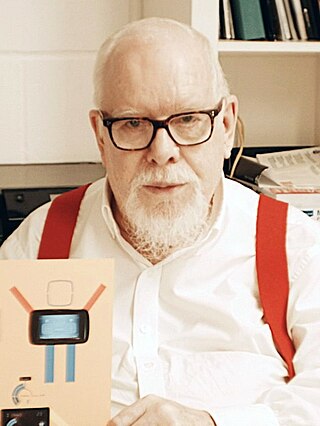
Sir Peter Thomas Blake is an English pop artist. He co-created the sleeve design for the Beatles' 1967 album Sgt. Pepper's Lonely Hearts Club Band. His other works include the covers for two of The Who's albums, the cover of the Band Aid single "Do They Know It's Christmas?", and the Live Aid concert poster. Blake also designed the 2012 Brit Award statuette.
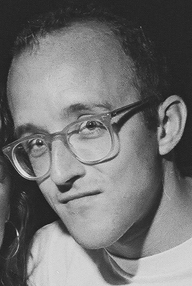
Keith Allen Haring was an American artist whose pop art emerged from the New York City graffiti subculture of the 1980s. His animated imagery has "become a widely recognized visual language". Much of his work includes sexual allusions that turned into social activism by using the images to advocate for safe sex and AIDS awareness. In addition to solo gallery exhibitions, he participated in renowned national and international group shows such as documenta in Kassel, the Whitney Biennial in New York, the São Paulo Biennial, and the Venice Biennale. The Whitney Museum held a retrospective of his art in 1997.

James Albert Rosenquist was an American artist and one of the proponents of the pop art movement. Drawing from his background working in sign painting, Rosenquist's pieces often explored the role of advertising and consumer culture in art and society, utilizing techniques he learned making commercial art to depict popular cultural icons and mundane everyday objects. While his works have often been compared to those from other key figures of the pop art movement, such as Andy Warhol and Roy Lichtenstein, Rosenquist's pieces were unique in the way that they often employed elements of surrealism using fragments of advertisements and cultural imagery to emphasize the overwhelming nature of ads. He was a 2001 inductee into the Florida Artists Hall of Fame.
In psychology, the Asch conformity experiments or the Asch paradigm were a series of studies directed by Solomon Asch studying if and how individuals yielded to or defied a majority group and the effect of such influences on beliefs and opinions.
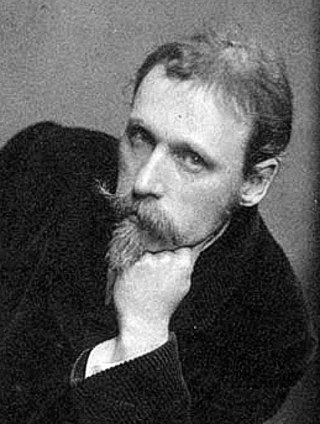
Walter Crane was an English artist and book illustrator. He is considered to be the most influential, and among the most prolific, children's book creators of his generation and, along with Randolph Caldecott and Kate Greenaway, one of the strongest contributors to the child's nursery motif that the genre of English children's illustrated literature would exhibit in its developmental stages in the later 19th century.
In psychology, a projective test is a personality test designed to let a person respond to ambiguous stimuli, presumably revealing hidden emotions and internal conflicts projected by the person into the test. This is sometimes contrasted with a so-called "objective test" / "self-report test", which adopt a "structured" approach as responses are analyzed according to a presumed universal standard, and are limited to the content of the test. The responses to projective tests are content analyzed for meaning rather than being based on presuppositions about meaning, as is the case with objective tests. Projective tests have their origins in psychoanalysis, which argues that humans have conscious and unconscious attitudes and motivations that are beyond or hidden from conscious awareness.

Marisol Escobar, otherwise known simply as Marisol, was a Venezuelan-American sculptor born in Paris, who lived and worked in New York City. She became world-famous in the mid-1960s, but lapsed into relative obscurity within a decade. She continued to create her artworks and returned to the limelight in the early 21st century, capped by a 2014 major retrospective show organized by the Memphis Brooks Museum of Art. The largest retrospective of Marisol's artwork, Marisol: A Retrospective has been organized by the Buffalo AKG Art Museum and curated by Cathleen Chaffee for these museums: the Montreal Museum of Fine Arts, the Toledo Museum of Art, the Buffalo AKG Art Museum, and the Dallas Museum of Art . Although it is supplemented by loans from international museums and private collections, the exhibition draws largely on artwork and archival material Marisol left to the Buffalo AKG Art Museum as a bequest upon her death.
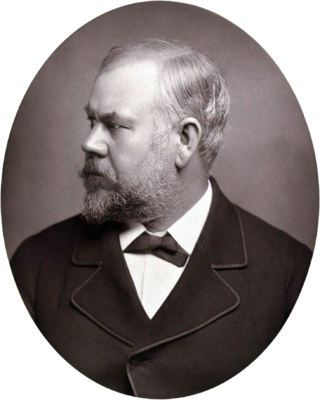
Henry Hugh Armstead was an English sculptor and illustrator, influenced by the Pre-Raphaelites.
Olga Lehmann was a British visual artist.
The Hat and Fragrance Textile Gallery is an exhibit space at Shelburne Museum in Shelburne, Vermont which houses quilts, hatboxes, and various other textiles. The name "Hat and Fragrance" refers both to Electra Havemeyer Webb's collection of hatboxes and to the fragrant, herbal sachets used to preserve textiles. In 1954, Shelburne Museum was the first museum to exhibit quilts as works of art; prior to this exhibition quilts were only shown as accessories in historic houses.
Albert J. Levis is a Greek-American psychiatrist and author of the Formal Theory of Behavior. He is also the founder and director of the Museum of the Creative Process in Manchester, Vermont. He along with his late wife, Georgette Wasserstein Levis, is the innkeeper of the Wilburton Inn, also in Manchester.
The Animal Metaphor Test is a projective psychological test created by Albert J. Levis, the director and founder of the Museum of the Creative Process, in 1988. The Animal Metaphor Test is one of many tests that are part of Levis' Conflict Analysis Battery, a collection of psychological tests.
Henry Gorski (1918–2010) was an American Figurative Expressionist artist. Born in Buffalo, New York, of Polish descent, Gorski received his BFA from the University at Buffalo in 1939. Gorski lived in the New Haven, Connecticut, area, and was married to the textile artist Bernie Gorski.
The Wilburton Inn is a historic hotel, restaurant, and estate located in Manchester Village, Vermont.
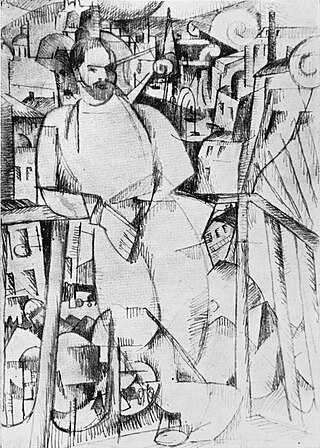
Man on a Balcony, is a large oil painting created in 1912 by the French artist, theorist and writer Albert Gleizes (1881–1953). The painting was exhibited in Paris at the Salon d'Automne of 1912. The Cubist contribution to the salon created a controversy in the French Parliament about the use of public funds to provide the venue for such 'barbaric art'. Gleizes was a founder of Cubism, and demonstrates the principles of the movement in this monumental painting with its projecting planes and fragmented lines. The large size of the painting reflects Gleizes's ambition to show it in the large annual salon exhibitions in Paris, where he was able with others of his entourage to bring Cubism to wider audiences.

The Tree, is a painting created in 1910 by the French artist Albert Gleizes. Executed in an advanced Proto-Cubist style, the work was exhibited in Paris at the Salon des Indépendants, 1910, the following year Gleizes chose to exhibit it at the Salon de la Section d'Or, Galerie La Boétie, 1912, and Manes Moderni Umeni, S.V.U., Vystava, Prague, 1914. The painting was again shown at the Grand Palais, Salon des Indépendants, Trente ans d'art indépendant, in 1926. L'Arbre, an important work of 1910, appeared at the decisive Salon des Indépendants of 1911, where Cubism emerged as a group manifestation and spread across the globe, at times shocking the general public.
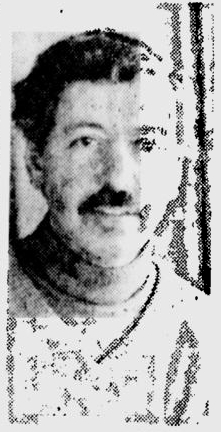
Daniel J. Robbins was an American art historian, art critic, and curator, who specialized in avant-garde 20th-century art and helped encourage the study of it. Robbins' area of scholarship was on the theoretical and philosophical origins of Cubism. His writings centered on the importance of artists such as Albert Gleizes, Jean Metzinger, Henri Le Fauconnier and Jacques Villon. He was a specialist in early Modernism, writing on Salon Cubists and championed contemporaries such as Louise Bourgeois and the Color Field painters. Art historian Peter Brooke referred to Robbins as "the great pioneer of the broader history of Cubism".

James Duard Marshall was a painter, lithographer, museum director, and art conservator who lived most of his life in Kansas City. Duard [pronounced "doo-erd"] was a student of Thomas Hart Benton and is best known for his 30-foot mural created for the centennial of Neosho, Missouri in 1939. The civic leaders of Neosho had approached Benton to produce the mural, as Benton had been born in Neosho, but he suggested that his student Marshall do the job. That mural hangs in the Neosho Newton County Library.
References
- ↑ "WilburtonInnVT". Wilburton Inn, Manchester Vermont, Inn, Lodging, Bed and Breakfast, Restaurant, Weddings, Retreats.
- ↑
- ↑ "Teleion Holon". arttoscience.org.
- ↑ "Teleion Holon". arttoscience.org.
- ↑ "Teleion Holon". arttoscience.org.
- ↑ Levis, Albert. Conflict Analysis: The Formal Theory of Behavior. Normative Publications, 1987
- ↑ Levis, Albert. Conflict Analysis Training. Normative Publications, 1987